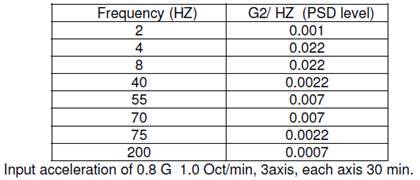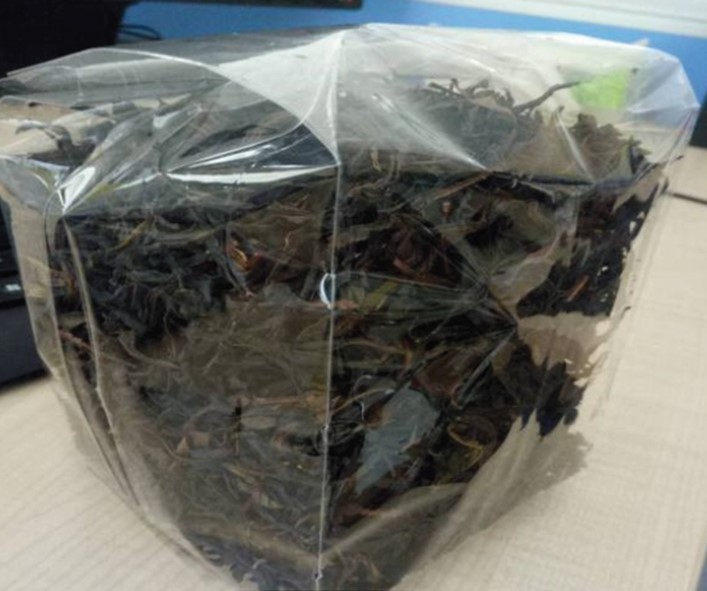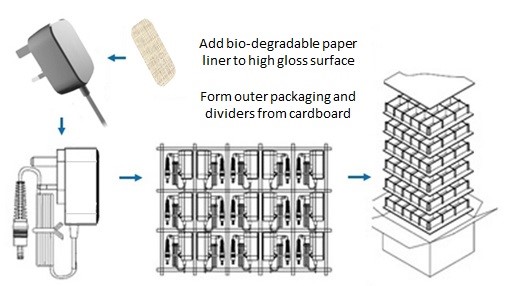Environmentally Sensitive / Recyclable Consumer Electronics Packaging Solutions
3 September 2018
Plastic waste is a well-known problem for the planet, but there IS an environmentally friendly packaging solution available to meet your requirements so why wait ..
Many consumer electronics products, including the complementary external psu’s have a high gloss finish as part of the design aesthetic. Whilst this is readily manufacturable, the consequence is often a need for “single use” plastic product packaging to protect the surface finish which then increases the environmental impact of the product.
Plastic waste is a well-known problem for the planet where it has been claimed that we're running out of landfill sites and only ~9% is recycled. As a consequence, the European Commission plans to make all plastic packaging recyclable by 2030:
This article therefore explores some of the issues for consideration when migrating to more environmentally sensitive consumer electronics packaging solutions.
Surface Finish Standard
When the product design is complete, it’s initially necessary to consider the surface finish location and specification. The Society of the Plastics Industry (SPI) has established standards defining the degree of polish on the inner surfaces of the molds used to form plastic products.
The SPI standards specify 12 grades of mold finish;
- SPI grades A-1, A-2 and A-3 specify highest gloss finishes with mirror sheen
- SPI grades B-1, B-2 and B-3 specify semi-gloss finishes with some sheen
- SPI's grades C-1, C-2 and C-3 specify matte finishes
- SPI grades D-1, D-2, D-3 specify dull, nonreflective finishes
The higher the standard of finish, the more challenging the packaging requirement. For instance, SPI A-2 is the most common standard when gloss surfaces are specified in consumers electronics products. Molded housings made to this grade shows no mold parting marks, tool or machining marks where the finish allows up to 2 millionths of an inch deviation from a perfect finish. These A grade finishes require careful protection during transportation as it would be very easy to abrade the surface and damage the finish. To design a suitable packaging solution it’s therefore necessary to specify the transportation tests that the packaging solution can be tested against to prove suitability.
Transportation Test Specifications
Transportation test specifications would normally include both vibration specifications and drop tests. A typical vibration specification covering frequency, orientation and duration would be as follows:
 Note the importance of the 3-axis definition, as testing on anything less than this may not replicate real-world transportation stresses!
Note the importance of the 3-axis definition, as testing on anything less than this may not replicate real-world transportation stresses!
A similarly comprehensive drop test spec would then be as follows:
Once this detail is known, it’s then possible to design a suitable environmentally friendly packaging solution to protect a defined product housing surface finish against the required transportation test specifications.
Packaging Options
Firstly, we should clarify the essential differences between ‘Recyclable’ vs ‘Bio-Degradable’, as whilst this may appear obvious we often find that these terms are used interchangeably which can lead to later confusion.
‘Recycling’ simply allows the base material to be reclaimed and reused. However, there are challenges associated with this;
- Recycling of plastics is generally performed by heating the molecular bonds that bind them together causing the material to break down. However, there is a huge range of different types of plastic used in packaging including thermosetting plastics which use polymers which becomes irreversibly hardened upon being cured. These cannot be recycled by normal heating methods as they simply burn, so not all plastics can be economically recycled.
- The recycling process itself adds to the base cost of the packaging material. In the extreme, thermosetting plastics can be recycled using chemical processes, but these are very costly and not deemed to be economically viable.
- Recycling ANY packaging requires an infrastructure to support the re-collection of the packaging. This includes space to store the used packaging prior to return transportation, all of which incur additional costs.
- Even when these challenges are met, recyclable packaging is often still discarded, so recyclable packaging on its own does not solve the pollution issue which requires a further change in consumer behaviour to be effective.
‘Bio-Degradable’ refers to the process whereby the base material can be naturally broken down (decomposed) rapidly by the action of microorganisms. This is considered to be the most environmentally friendly. Examples include plant based materials such as wood, paper, cardboard etc. Whilst all such materials can be readily recycled if such infrastructure exists, they can also be disposed of using the existing waste infrastructure without the associated environmental impact whilst consumer behaviour evolves.
Whilst this sounds ideal, there are additional considerations. For example, the standard approach to protecting a high gloss finish is to use a flexible thermoplastic film. A bio-degradable film would appear to be the best alternative solution and there are many such oxo-biodegradable plastics (OBP) plastics available where the polymers degrade to water, carbon dioxide and biomass. However, on further scrutiny it appears that the fast degradation is only guaranteed in controllable compostable conditions and in uncontrolled conditions (such as in open water or free air) this may take two years and sometimes much longer! This does not constitute a rapid decomposition which has also been noted by the European Commission who will now take steps to restrict the use of oxo-biodegradable plastics (OBP) across the EU following concerns over degradation time and residual microplastics fragments that can still pollute the environment. https://www.mrw.co.uk/latest/eu-to-restrict-oxo-biodegradable-plastics/10027160.article
Fortunately, there are many other organic solutions that do completely bio-degrade without such environmental considerations. One such example is plant starch (such as corn or cassava) illustrated below which can be converted into various forms of carton and liner, such as sheets and bags. However, these may still be abrasive so may not be suitable on their own depending on the actual protection requirements.

Other examples include cardboard to paper materials, of which there are a number of variants available which can be formed into adhesive sheets including;
• Biodegradable liner - A biodegradable paper and adhesive that breaks down slowly but fully in normal environmental conditions.
• Water soluble, biodegradable liner - Paper and adhesive that can completely dissolve in 30 seconds or less in water.
This article is not meant to provide a comprehensive list of all environmentally friendly packaging options. Fortunately, this is an area that has attracted considerable research with new solutions and suppliers appearing on a regular basis, so this article is simply to highlight that there are MANY options available, regardless of your product design and specification.
Packaging Solution Proposal
It is critical to note that ALL PACKAGING SOLUTIONS have advantages and disadvantages that would require thorough testing and analysis to determine suitability. Indeed, the final environmentally friendly packaging solution may be a composite of many such elements such as a protective biodegradable paper liner and cable tie, with cardboard dividers, trays and a cardboard outer carton as illustrated with the psu below.


